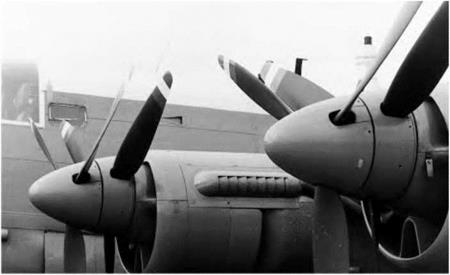The slipstream
The propeller produces thrust by forcing the air backwards, and the resultant stream of air which flows over the fuselage, tail units, and other parts of the aeroplane is called the slipstream.
The extent of the slipstream may be taken roughly as being that of a cylinder of the same diameter as the propeller. Actually there is a slight contraction of the diameter a short distance behind the propeller.
The velocity of the slipstream is greater than that at which the aeroplane is travelling through the air; the increase in velocity may be as much as 100 per cent, or even more, at the stalling speed of the aeroplane. This means that the
|
|
Fig 4K Contra-rotating propellers
Four sets of these six-bladed contra-rotating propellers were employed to propel the old Shackleton patrol aircraft. The noise inside the fuselage, which had no padding or sound absorption material, made the long duration flights decidedly arduous for the crew.
velocity of the air flowing over all those parts in the slipstream is twice that of the airflow over the other parts, and so the drag is four times as great as corresponding parts outside the slipstream. At higher forward speeds the difference is not as great, being only about 50 per cent at normal speeds, and as little as 10 per cent at high speeds. The extra velocity of the slipstream may be beneficial in providing more effective control for rudder and elevators, especially when the aeroplane is travelling slowly through the air, e. g. when taxying, or taking off, or flying near the stalling speed. With jet propulsion, however, it is not advisable for the hot jet to strike the tail plane which, in consequence, is often set very high (Fig. 5F).
In addition to increased velocity, the propeller imparts a rotary motion to the slipstream in the same direction as its own rotation; so it will strike one side only of such surfaces as the fin, and so may have considerable effects on the directional and lateral balance of the aeroplane. If these effects are compensated for in normal flight – e. g. by offsetting the fin so that it does not lie directly fore and aft – then the balance will be upset when the engine stops and the slipstream ceases to exert its influence.
Gyroscopic effect
The rotating mass of the propeller or the compressor in the case of a jet engine may cause a slight gyroscopic effect. A rotating body tends to resist any change in its plane of rotation, and if such change does take place there is superimposed a tendency for the plane of rotation to change also in a direction at right angles to that in which it is forced. This can easily be illustrated with an ordinary bicycle wheel; if the wheel, while rapidly rotating, is held on a horizontal shaft and the holder attempts to keep the shaft horizontal while he turns, the shaft will either tilt upwards or downwards according to whether he turns with the opposite or the same sense of rotation as that of the wheel. Thus if the propeller rotates clockwise when viewed from the pilot’s cockpit (the usual method of denoting the rotation), the nose will tend to drop on a right-hand turn and the tail to drop on a left-hand turn. It is only in exceptional cases that this effect is really appreciable, although it used to be very marked in the days of rotary engines when the rotating mass was considerable.












